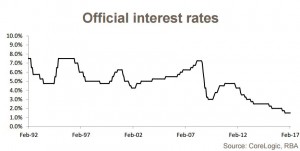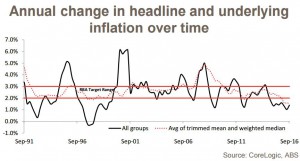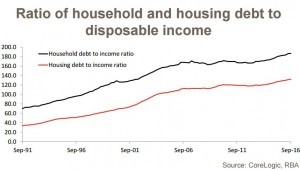With interest rates are at historic lows, it would be unlikely to see rates increase in the short-term future.
Furthermore, he’s not expecting interest rates to return to historic average levels due to record high levels of household debt.
The Reserve Bank (RBA) Governor Phil Lowe suggested last week that if it wasn’t for the strength of the housing market, and a fear of inflating it further, official interest rates would be lower.
It was an interesting comment from an RBA Governor, especially when you read what the RBA’s function is: The (RBA) is Australia’s central bank and derives its functions and powers from the Reserve Bank Act 1959.
Its duty is to contribute to the stability of the currency, full employment, and the economic prosperity and welfare of the Australian people.
It does this by setting the cash rate to meet an agreed medium-term inflation target, working to maintain a strong financial system and efficient payments system, and issuing the nation’s banknotes.
Inflation is currently well below the RBAs target range and the country is not at full-employment which would indicate the RBA should be considering interest rate cuts.
Clearly the economic prosperity and welfare of Australian people (linked to dwelling value growth) is a key reason why they are not cutting interest rates.
When you look at some of the key data, it seems like it could still be a long time before the RBA starts lifting interest rates again.
The RBA has a target range for underlying inflation of between 2% to 3% over the medium term.
The main mechanism to increase inflation is by cutting interest rates; at the moment the annual rate of headline inflation is 1.5% while underlying inflation is 1.6%, both of which are below the target range.
In fact, annual underlying inflation has grown at a rate below 2% for each of the past four quarters with inflation having not been that consistently weak since the RBA implemented its inflation targeting policy in the early 1990’s.
Under normal circumstances the RBA would likely be cutting official interest rates in an effort to stimulate consumption and push consumer prices higher, however, concerns of further inflating Sydney and Melbourne home values is likely a significant barrier to making this move.
At the same time the economy is experiencing low inflation, weekly wages are increasing at their slowest annual pace on record.
Over the 12 months to December 2016 the Australian Bureau of Statistics (ABS) wage price index has increased by 1.9%.
The Index has been published since September 1997 and this is the lowest annual increase on record.
With wage increases sluggish at best, the prospects of consumer spending picking up and lifting inflation remain muted.
At a time with record low interest rates, wage growth and low inflation the Australian economy is also experiencing record high levels of household debt.
At the end of the September 2016 quarter, the ratio of household debt to disposable income was a record-high 186.9% while the ratio of housing debt to disposable income was also at a record-high 132.2%.
The high level of household debt certainly goes some way to explaining why households are spending less (outside of housing in Sydney and Melbourne).
It should also be noted that the ratios of household (885.7%) and housing (481.1%) assets to disposable income are currently also at record highs.
This indicates that although debt is extremely high, the value of the assets that debt is held against is also high.
Keep in mind, these assets are largely housing assets which are not liquid so utilising the value of the assets is more difficult than if it was available as cash or in more liquid assets such as shares.
When you combine all of these factors it becomes clear firstly that were it not for the strength in growth in dwelling values in Sydney and Melbourne, official interest rates could be even lower than their current record lows.
The RBA has already stated that their forecast is for headline inflation to be back within their target range late this year with underlying inflation taking longer to reach the target range.
The trend in wages growth remains subdued, meanwhile household debt is still rising.
Based on these factors, it is likely to be some time before the RBA is in a position to raise interest rates and with household debt at historic highs we would expect the eventual increases to be slow and unlikely to result in interest rates returning to historic average levels.





No comments:
Post a Comment